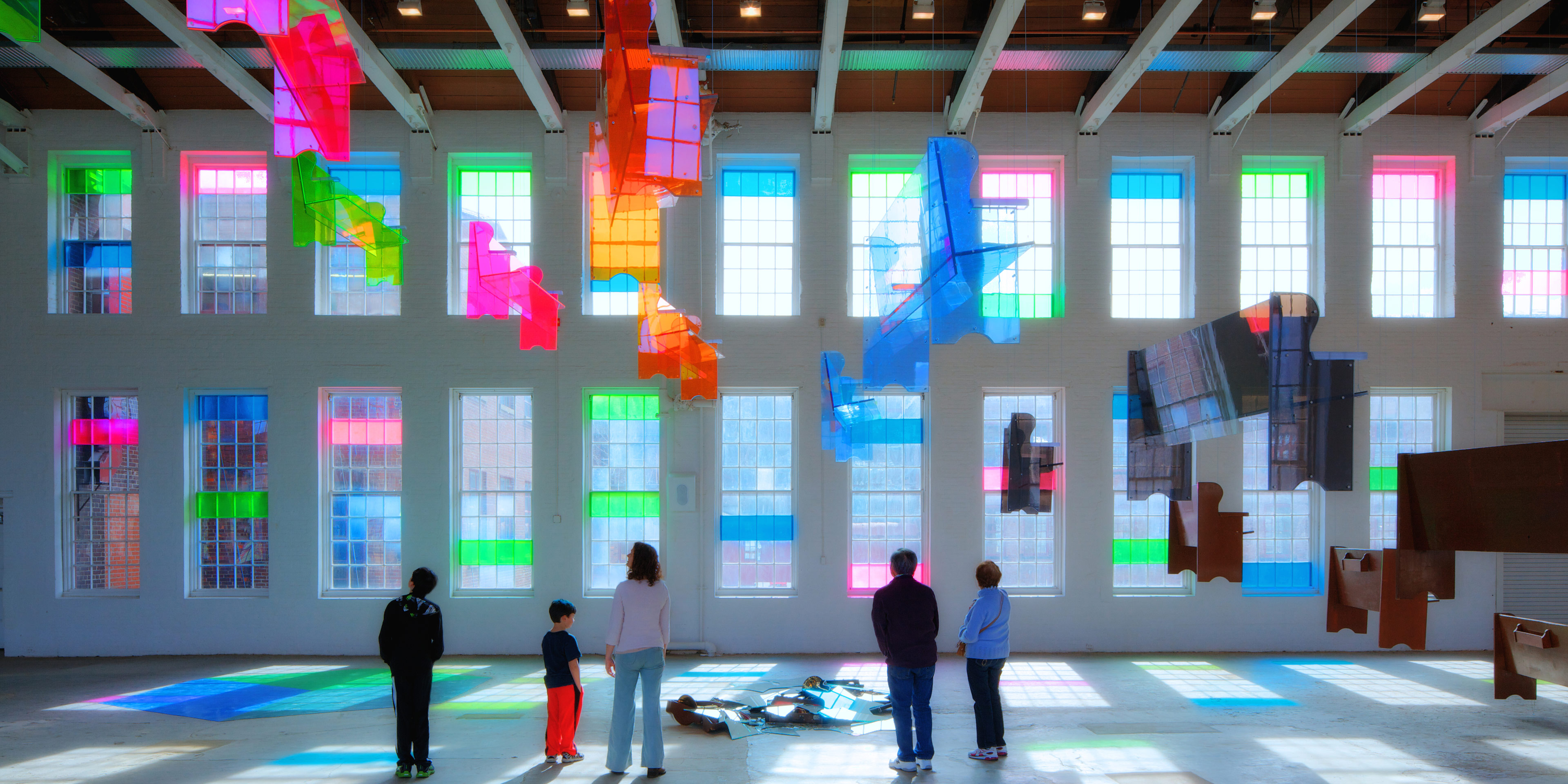Archive, Archive Exhibitions, Exhibition
- May 23, 2012 - October 29, 2012
- Building 5
The Cartographer’s Conundrum was a major multi-disciplinary installation by New York-based artist Sanford Biggers. This new work was inspired by the Houston, Texas-based artist, scholar, and Afro-futurist John Biggers (1924-2001). A cousin of his subject, Sanford Biggers’ goal was to both study and expand the emerging genre of Afrofuturism, which engages science fiction, cosmology, and technology to create a new folklore of the African Diaspora while simultaneously illuminating the underrepresented career of master painter and muralist John Biggers.
Afrofuturism was a term coined in 1995 by cultural critic Mark Dery in his essay Black to the Future, where he links the African-American use of science and technology to an examination of space, time, race, and culture. In this text Dery defines Afrofuturism as “speculative fiction that treats African-American themes and addresses African-American concerns in the context of 20th-century technoculture—and, more generally, African-American signification that appropriates images of technology and a prosthetically enhanced future.” The movement began in earnest in the mid-1950s with musician Sun-Ra, whose music blended science fiction, mysticism, African culture (with a particular focus on Egypt), and jazz fusion, all of which coalesced in his 1972 film Space in the Place. In 1975, George Clinton formed his bands Parliament and Funkadelic, which took Afrofuturism to new and often absurdist heights. Today the movement is still strong, encompassing contemporary musicians such as Saul Williams, Janelle Monae, OutKast, and DJ Spooky, along with writers such as Paul Beatty, films such as The Matrix, Blade, and Chronicles of Riddick, and visual artists such as Sanford Biggers.
This use of Afrofuturist imagery and ideologies links both Sanford and John Biggers’ work. John Biggers began as a mural painter in the genre of social realism—portraying African-American life. His work took a shift when in 1957 he won a UNESCO fellowship, becoming one of the first African-American artists to travel to Africa. His trip took him to West Africa, and later he traveled to Nigeria and other African countries. This experience had a profound impact on his work, which afterwards took these African themes, merging them with his images of African-American life to create allegories about life, spirituality, hope, and survival. John Biggers’ work also touched upon Afrofuturism in his use of sacred and fractal geometries and mystical imagery.
Sanford Biggers had always been inspired by his cousin’s work and journey. So, after being awarded a Creative Capital grant in 2008, Sanford used the opportunity to conceive of a new project that would place him and his cousin side by side. Sanford began by traveling through western Africa along the same route that John Biggers followed in the 1950s, meeting with colleagues and family members along the way.
A native of Los Angeles, California, and current New York resident, Sanford Biggers uses the study of ethnological objects, popular icons, and the Dadaist tradition to explore cultural and creative syncretism, art history, and politics. An accomplished musician, Biggers often incorporates performative elements into his sculptures and installations, resulting in multilayered works that act as anecdotal vignettes, at once full of wit and clear formal intent.
Biggers has won several awards including The Creative Time Travel Grant, Creative Capital Project Grant, New York Percent for the Arts Commission, Art Matters Grant, New York Foundation for the Arts Award in performance art/multidisciplinary work, the Lambent Fellowship in the arts, and the Rema Hort Mann Foundation Award Grant. Biggers’ installations, videos, and performances have appeared in venues worldwide including the Tate Britain and Tate Modern, London; the Whitney Museum and Studio Museum in Harlem, New York; and the Yerba Buena Center for the Arts, San Francisco; as well as institutions in China, Germany, Hungary, Japan, Poland, and Russia. His work has been included in exhibitions such as Prospect 1/ New Orleans Biennial, Illuminations at the Tate Modern, Performa 07, the Whitney Biennial, and Freestyle at the Studio Museum in Harlem. He has also had solo exhibitions at Grand Arts, Kansas City; Mary Goldman Gallery, Los Angeles; Kenny Schachter’s ROVE Gallery, London; Triple Candie, New York; D’Amelio Terras Gallery, New York; Contemporary Art Museum, Houston; Matrix/Univ.of Berkeley Museum, Berkeley; and Zamek Ujazdowski, Warsaw. Biggers has taught at Virginia Commonwealth University’s Sculpture and Expanded Media program and was a visiting scholar at Harvard University’s Visual and Environmental Studies and Office for the Arts Departments. He teaches at Columbia University.
Major support provided by The Andy Warhol Foundation for the Visual Arts, with additional support from the National Endowment for the Arts, The Toby D. Lewis Philanthropic Fund of the Jewish Community Federation of Cleveland, and the Massachusetts Cultural Council. Special thanks to Sheffield Plastics, John Keal Music, Bascom Lodge, and Creative Capital.
Sanford Biggers, Constellation II, 2009
Dimensions variable, steel, plexiglass, LEDs, Zoopoxy, cotton quilt, original printed cotton tile
![]()


